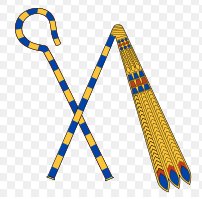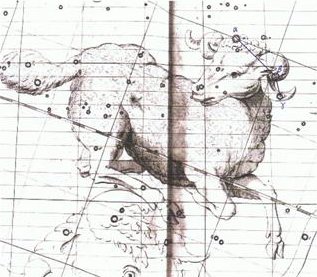Where was the Sun King?. In the times of Al Sharatain the Sun King should have 'made landfall' at the First Point of Aries - the point where land succeeded the waters of the Sea. Here there should have been plenty of fresh grass to graze, which could explain the eating (kai) gestures:
Above I have kept the dates connected to the glyphs as earlier, e.g. with April 17 (107) equal to equinox + 27 days, although the glyphs evidently are to be read together with the heliacal stars in the preceding day, e.g. Polaris (26.6) - which therefore in a way can be thought of as Polaris (27) instead of Polaris (26). The first kai gesture has a clear Sign, a great eating hand where its top finger is drawn as a horn, probably a way to point at the First Point of Aries.
Below this 'pointed horn' we can see a little henua and the meaning could be to demonstrate the return of life (land, light).  The central raaraa glyph has according to my list no Aries star. Both Alrisha (the Knot in Pisces) and Alamak (the desert cat in Andromeda) can, however, be perceived as 'no more water' signs. These stars are both the last in their respective constellations. From day 30 (after equinox) to day 366 (*Ca14-3) there were 336 days and 336 = 42 * 8. They are looking straight at us, the pair in Ca2-2--3, as if arrested in the midst of walking ahead. I have interpreted tagata glyphs as 'fully grown', no longer changing. When the Polynesians kept their old star calendar instead of following the ever earlier Sun in his cycle it in a way meant they had made him stop. To follow the Sun equinox out onto the open and perilous Sea would have been totally unacceptable. Because the old map of the night sky had clearly made a division between Land and Water. ... The first half beginning with Alef - an ox, and ending with Lamed - a whip. The second list begins with Mem - water, and continues with Nun - fish, Samek - fish bones, Ayin - a water spring, Peh - the mouth of a well, Tsadi - to fish, Kof, Resh and Shin are the hook hole, hook head and hook teeth, known to exist from prehistoric times, and the Tav is the mark used to count the fish caught. Therefore the Sun's retrograde advance had to be stopped at Land's End. This point came precisely after Polaris, the star at the pole. At Ana-nia one could fish, at Al Sharatain not:
Polaris marked the last point of the 'Sea', the last point where fish could be caught: ... Uoke's pole broke, and, in this way, at least Nga Tavake's landing site remained (of the formerly great land). Possibly the 'pole' of Uoke was said to have broken because his beam across from one equinox to the other no longer was allowed to rule.
The Rogo (Lono) type of glyph may have marked where in the times of Al Sharatain the old year ended (Terminalia) and then followed 5 weeks to equinox:
The front wing of Rogo in Cb14-12 (where 14 * 12 = 168 = 336 / 2) makes a return curve (crook) which ends in nothing: 
| |||||||||||||||||||||||||||||||||||||||||||||||||||||||||||||||||||||||||||||||||









